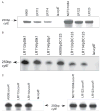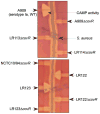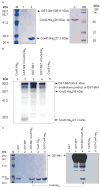Regulation of cytotoxin expression by converging eukaryotic-type and two-component signalling mechanisms in Streptococcus agalactiae
- PMID: 17005013
- PMCID: PMC2593684
- DOI: 10.1111/j.1365-2958.2006.05431.x
Regulation of cytotoxin expression by converging eukaryotic-type and two-component signalling mechanisms in Streptococcus agalactiae
Abstract
Signal transducing mechanisms are essential for regulation of gene expression in both prokaryotic and eukaryotic organisms. Regulation of gene expression in eukaryotes is accomplished by serine/threonine and tyrosine kinases and cognate phosphatases. In contrast, gene expression in prokaryotes is controlled by two-component systems that comprise a sensor histidine kinase and a cognate DNA binding response regulator. Pathogenic bacteria utilize two-component systems to regulate expression of their virulence factors and for adaptive responses to the external environment. We have previously shown that the human pathogen Streptococcus agalactiae (Group B Streptococci, GBS) encodes a single eukaryotic-type serine/threonine kinase Stk1, which is important for virulence of the organism. In this study, we aimed to understand how Stk1 contributes to virulence of GBS. Our results indicate that Stk1 expression is important for resistance of GBS to human blood, neutrophils and oxidative stress. Consistent with these observations, Stk1 positively regulates transcription of a cytotoxin, beta-haemolysin/cytolysin (beta-H/C) that is critical for survival of GBS in the bloodstream and for resistance to oxidative stress. Interestingly, positive regulation of beta-H/C by Stk1 requires the two-component regulator CovR. Further, we show that Stk1 can negatively regulate transcription of CAMP factor in a CovR-dependent manner. As Stk1 phosphorylates CovR in vitro, these data suggest that serine/threonine phosphorylation impacts CovR-mediated regulation of GBS gene expression. In summary, our studies provide novel information that a eukaryotic-type serine/threonine kinase regulates two-component-mediated expression of GBS cytotoxins.
Figures









Similar articles
-
Group B streptococcal haemolysin and pigment, a tale of twins.FEMS Microbiol Rev. 2014 Sep;38(5):932-46. doi: 10.1111/1574-6976.12071. Epub 2014 Apr 4. FEMS Microbiol Rev. 2014. PMID: 24617549 Free PMC article. Review.
-
Threonine phosphorylation prevents promoter DNA binding of the Group B Streptococcus response regulator CovR.Mol Microbiol. 2009 Mar;71(6):1477-95. doi: 10.1111/j.1365-2958.2009.06616.x. Epub 2009 Jan 23. Mol Microbiol. 2009. PMID: 19170889 Free PMC article.
-
The Abi-domain protein Abx1 interacts with the CovS histidine kinase to control virulence gene expression in group B Streptococcus.PLoS Pathog. 2013 Feb;9(2):e1003179. doi: 10.1371/journal.ppat.1003179. Epub 2013 Feb 21. PLoS Pathog. 2013. PMID: 23436996 Free PMC article.
-
Serine/threonine phosphatase Stp1 mediates post-transcriptional regulation of hemolysin, autolysis, and virulence of group B Streptococcus.J Biol Chem. 2011 Dec 23;286(51):44197-44210. doi: 10.1074/jbc.M111.313486. Epub 2011 Nov 11. J Biol Chem. 2011. PMID: 22081606 Free PMC article.
-
Regulation of transcription by eukaryotic-like serine-threonine kinases and phosphatases in Gram-positive bacterial pathogens.Virulence. 2014;5(8):863-85. doi: 10.4161/21505594.2014.983404. Virulence. 2014. PMID: 25603430 Free PMC article. Review.
Cited by
-
Strain-specific regulatory role of eukaryote-like serine/threonine phosphatase in pneumococcal adherence.Infect Immun. 2012 Apr;80(4):1361-72. doi: 10.1128/IAI.06311-11. Epub 2012 Feb 6. Infect Immun. 2012. PMID: 22311926 Free PMC article.
-
A hemolytic pigment of Group B Streptococcus allows bacterial penetration of human placenta.J Exp Med. 2013 Jun 3;210(6):1265-81. doi: 10.1084/jem.20122753. Epub 2013 May 27. J Exp Med. 2013. PMID: 23712433 Free PMC article.
-
Group B Streptococci lyse endothelial cells to infect the brain in a zebrafish meningitis model.PLoS Biol. 2025 Jul 3;23(7):e3003236. doi: 10.1371/journal.pbio.3003236. eCollection 2025 Jul. PLoS Biol. 2025. PMID: 40609050 Free PMC article.
-
Convergence of PASTA Kinase and Two-Component Signaling in Response to Cell Wall Stress in Enterococcus faecalis.J Bacteriol. 2018 May 24;200(12):e00086-18. doi: 10.1128/JB.00086-18. Print 2018 Jun 15. J Bacteriol. 2018. PMID: 29632091 Free PMC article.
-
Group B streptococcal haemolysin and pigment, a tale of twins.FEMS Microbiol Rev. 2014 Sep;38(5):932-46. doi: 10.1111/1574-6976.12071. Epub 2014 Apr 4. FEMS Microbiol Rev. 2014. PMID: 24617549 Free PMC article. Review.
References
-
- Av-Gay Y, Everett M. The eukaryotic-like Ser/Thr protein kinases of Mycobacterium tuberculosis. Trends Microbiol. 2000;8:238–244. - PubMed
-
- Baker CJ, Edwards MW. Group B streptococcal infections. In: Remington JS, Klein JO, editors. Infectious Diseases of the Fetus and Newborn Infant. Philadelphia, PA: W.B. Saunders; 1995. pp. 980–1054.
-
- Beier D, Gross R. Regulation of bacterial virulence by two-component systems. Curr Opin Microbiol. 2006;9:143–152. - PubMed
-
- Chaffin DO, Rubens CE. Blue/white screening of recombinant plasmids in Gram-positive bacteria by interruption of alkaline phosphatase gene (phoZ) expression. Gene. 1998;219:91–99. - PubMed
Publication types
MeSH terms
Substances
Grants and funding
LinkOut - more resources
Full Text Sources
Research Materials
Miscellaneous

